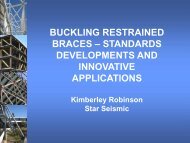Environmental Impacts of Multi-Storey Buildings Using Different ...
Environmental Impacts of Multi-Storey Buildings Using Different ...
Environmental Impacts of Multi-Storey Buildings Using Different ...
Create successful ePaper yourself
Turn your PDF publications into a flip-book with our unique Google optimized e-Paper software.
Timber Plus ProjectSummary <strong>of</strong> the Timber Plus Project.The University <strong>of</strong> Canterbury has been engaged by the Ministry <strong>of</strong> Agriculture and Forestry to investigate theenvironmental impacts <strong>of</strong> multi-storey buildings using different construction materials.The University have chosen to create a virtual model <strong>of</strong> a concrete framed building currently underconstruction. <strong>Using</strong> this model as a baseline, two further models have been developed. The first <strong>of</strong> theseuses timber in ways which are traditional and accepted within the New Zealand construction industry, thesecond seeks to explore new methods and areas in which timber can be utilised. This second alternativemodel has been titled “The Timber Plus Building”.The lifetime energy use together with the embodied energy <strong>of</strong> each building has been calculated for each <strong>of</strong>the three models and potential environmental impacts assessed wherever possible.The Brief.Warren and Mahoney have been asked to provide advice specifically regarding the timbers used within theTimber Plus building. This advice is to ensure that:-• The embodied energy <strong>of</strong> the building is minimised.• The maximum green-star rating for the building is achieved.• The timber specified can be obtained from sustainable sources.• The timber specified is suitable for the location and purpose.• Timber treatments used, if any, are kept to a minimum and are environmentally preferable.• Additional opportunities to maximise timber are identified.• End <strong>of</strong> life disposal / re-use is achieved with minimum environmental impact.It is acknowledged that this is a theoretical study and will only be presented as such.Embodied Energy.The embodied energy <strong>of</strong> an element is defined as the total amount <strong>of</strong> energy that is required to extract,transport, manufacture and construct that element. It covers the period “from cradle to gate” without takinginto account end <strong>of</strong> life disposal.For a brick this would include the energy required to extract the clay, to transport it to the brick-works, to pumpthe water, to mould it into shape, to fire it, to deliver it to site and to put it into place. In such an example theenergy to fire the brick would stand out as a major energy input.For a material such as timber, the embodied energy would include the energy required to harvest, to re-plant,to transport it to the saw mill, to process it and deliver the finished product to site and finally to install it. Astimber requires relatively little energy to plant or to grow, transportation and milling become the key areas toexamine. The timber used within a building should first and foremost be suitable for the application it isintended for and its harvesting should be carried out in a sustainable manner. Once these criteria are metproducts that require the least energy to deliver to site should be preferred.Page 2 <strong>of</strong> 21 May 2008
















